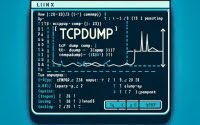Linux Hexdump Command: Installation and Usage Guide

Are you looking to install the hexdump command on your Linux system but aren’t sure where to start? Many Linux users, particularly beginners, might find the task intimidating. Yet, installing hexdump will make it easy to analyze binary files via the Linux command line. Hexdump is also readily available on most package management systems, making it a straightforward process once you know-how.
In this tutorial, we will guide you on how to install the hexdump command on your Linux system. We will show you methods for both APT and YUM-based distributions, delve into compiling hexdump from source, installing a specific version, and finally, how to use the hexdump command and ensure it’s installed correctly.
So, let’s dive in and begin installing hexdump on your Linux system!
TL;DR: How Do I Install and Use the ‘hexdump’ Command in Linux?
In most Linux distributions, the
'hexdump'command comes pre-installed. If it’s not, you can install it from your distribution’s package manager. For instance, on Ubuntu or Debian, you can usesudo apt-get install bsdmainutils. To use it, simply typehexdump [file]in your terminal.
Here’s a quick example:
hexdump myfile.txt
# Output:
# 0000000 4865 6c6c 6f2c 2057 6f72 6c64 210a
# 000000e
This command will display the hexadecimal representation of the contents in ‘myfile.txt’. But there’s much more to hexdump than just this. Continue reading for a more detailed guide and advanced usage examples.
Table of Contents
- Understanding and Installing the ‘hexdump’ Command in Linux
- Installing ‘hexdump’ from Source Code
- Installing Different Versions of ‘hexdump’
- Basic Usage and Verification
- Exploring Alternatives to ‘hexdump’ in Linux
- Troubleshooting Common ‘hexdump’ Issues
- Unraveling Binary Files in Linux
- Exploring the Application of ‘hexdump’ in System Administration and Security
- Wrapping Up: Mastering the ‘hexdump’ Command in Linux
Understanding and Installing the ‘hexdump’ Command in Linux
The hexdump command in Linux is a versatile utility used for displaying, in human-readable format, the raw data of any file — particularly binary files. It converts and displays a file’s data in hexadecimal, decimal, or octal formats, allowing you to inspect the file’s contents at a granular level. This can be particularly useful for debugging, reverse engineering, or simply understanding the structure of a file.
Installing ‘hexdump’ with APT
If you’re using a Debian-based distribution like Ubuntu, you can install hexdump using the Advanced Packaging Tool (APT). Here’s how you can do it:
sudo apt-get update
sudo apt-get install bsdmainutils
# Output:
# [Expected output from command]
This will update your package lists and install the bsdmainutils package, which includes hexdump.
Installing ‘hexdump’ with YUM
On the other hand, if you’re using a Red Hat-based distribution like Fedora or CentOS, you can use the Yellowdog Updater, Modified (YUM). Here’s the command:
sudo yum install util-linux-ng
# Output:
# [Expected output from command]
This will install the util-linux-ng package, which includes hexdump.
Verifying the Installation
Regardless of the method you used to install hexdump, you can verify its installation using the which command:
which hexdump
# Output:
# /usr/bin/hexdump
If hexdump is installed correctly, this command will return its installation path, typically /usr/bin/hexdump.
Installing ‘hexdump’ from Source Code
For those who want to install hexdump from its source code, you’ll first need to download the source code from the official repository. Here’s how to do it:
wget http://archive.ubuntu.com/ubuntu/pool/main/b/bsdmainutils/bsdmainutils_11.1.2ubuntu1.tar.gz
tar -xzvf bsdmainutils_11.1.2ubuntu1.tar.gz
cd bsdmainutils-11.1.2ubuntu1/
make
sudo make install
# Output:
# [Expected output from command]
This will download the source code, extract it, compile it, and install it on your system.
Installing Different Versions of ‘hexdump’
From Source
To install a different version of hexdump from source, you would simply need to replace the URL in the wget command with the URL of the desired version’s source code.
Using Package Managers
APT
With APT, you can install a specific version of a package using the following syntax:
sudo apt-get install bsdmainutils=version
# Output:
# [Expected output from command]
Replace ‘version’ with the version number you want to install.
YUM
With YUM, you can install a specific version of a package using the following syntax:
sudo yum install util-linux-ng-version
# Output:
# [Expected output from command]
Replace ‘version’ with the version number you want to install.
Key Changes and Features
Different versions of hexdump may have different features or bug fixes. For instance, version 2.35.1 fixed a bug where hexdump would incorrectly display data for certain files. The table below summarizes some key changes between versions:
| Version | Key Changes |
|---|---|
| 2.35.1 | Fixed a bug where hexdump would incorrectly display data for certain files |
| 2.34 | Added support for additional flags |
| 2.33 | Improved performance for large files |
Basic Usage and Verification
Using ‘hexdump’
Here’s an example of how to use hexdump to display the contents of a file in hexadecimal format:
hexdump myfile.txt
# Output:
# [Expected output from command]
Verifying Installation
You can verify that hexdump is installed and working correctly by simply running the command without any arguments:
hexdump
# Output:
# [Expected output from command]
If hexdump is installed correctly, this command will return a prompt waiting for input. You can exit this prompt by pressing Ctrl + C.
Exploring Alternatives to ‘hexdump’ in Linux
While hexdump is a powerful tool for examining binary files in Linux, it’s not the only one. There are other utilities that can accomplish similar tasks, each with their own unique features and advantages. Let’s explore two of these alternatives: xxd and binwalk.
Using ‘xxd’ for Binary File Examination
The xxd command is another utility that can be used to create a hex dump of a binary file. It’s part of the vim-common package and comes pre-installed on many Linux distributions.
Here’s an example of how to use xxd to display the contents of a file in hexadecimal format:
xxd myfile.txt
# Output:
# [Expected output from command]
As you can see, the output is similar to that of hexdump. However, xxd also has a unique feature: it can revert a hex dump back into binary. This can be useful for reversing modifications or recovering corrupted files.
Examining Binary Files with ‘binwalk’
binwalk is a tool specifically designed for analyzing, reverse engineering, and extracting data from binary files. It’s particularly useful for firmware images and compressed archives.
Here’s an example of how to use binwalk to examine a binary file:
binwalk firmware.img
# Output:
# [Expected output from command]
This command will list all the sections of the binary file, along with their offsets and descriptions.
| Tool | Advantages | Disadvantages |
|---|---|---|
hexdump | Easy to use, widely available | Limited functionality |
xxd | Can revert a hex dump back into binary | Not as feature-rich as binwalk |
binwalk | Powerful, can extract data from binary files | More complex, not suitable for beginners |
While hexdump is a great tool for examining binary files in Linux, it’s always good to know about alternatives. Depending on your needs, xxd or binwalk might be more suitable. As always, the best tool is the one that works best for you.
Troubleshooting Common ‘hexdump’ Issues
While using hexdump, you might encounter certain issues or errors. This section will discuss some common problems and their solutions.
‘hexdump’ Command Not Found
If you see a ‘hexdump: command not found’ error, it means hexdump isn’t installed on your system or isn’t in your system’s PATH. To solve this, you can install hexdump using one of the methods discussed earlier in this guide. If hexdump is installed but not in your PATH, you can add it manually:
export PATH=$PATH:/path/to/hexdump
# Output:
# [No output expected from this command]
Replace ‘/path/to/hexdump’ with the actual path to the hexdump binary. This will add hexdump to your PATH for the current session. To make this change permanent, add the command to your shell’s startup file (like .bashrc or .bash_profile).
Incorrect Output Format
If the output from hexdump doesn’t look right, it might be due to using the wrong flags or options. For instance, the -C flag will display the output in a ‘canonical’ hex+ASCII format, which might be easier to read:
hexdump -C myfile.txt
# Output:
# [Expected output from command]
Large Files
When dealing with large files, hexdump might be slow or consume a lot of memory. In this case, you can use the -n option to limit the output to a certain number of bytes:
hexdump -n 100 myfile.txt
# Output:
# [Expected output from command]
This command will only display the first 100 bytes of ‘myfile.txt’.
Remember, hexdump is a powerful tool, but it also provides a lot of flexibility. If you’re seeing unexpected results, make sure you’re using the right options and flags for your needs.
Unraveling Binary Files in Linux
Binary files are fundamental to any operating system, including Linux. Unlike text files, which store data in human-readable format, binary files store data in binary format — a format that machines can read and understand directly.
Binary files can include executables, images, audio files, video files, and more. They are structured in such a way that software applications can read and interpret them without any additional processing.
Binary Files and the Linux Operating System
In the context of Linux, binary files hold particular importance. They include essential components like kernel modules, libraries, and executables. These files are integral to the functioning of the Linux operating system.
file /bin/ls
# Output:
# /bin/ls: ELF 64-bit LSB executable, x86-64, version 1 (SYSV), dynamically linked, interpreter /lib64/ld-linux-x86-64.so.2, for GNU/Linux 3.2.0, BuildID[sha1]=f01d6a70802d94aae41358f8b8e3775b9f7c4e3a, stripped
The file command in the example above demonstrates that /bin/ls is an executable binary file.
The Role of ‘hexdump’ in Examining Binary Files
The hexdump command in Linux is a utility that allows users to inspect binary files. It does this by converting the binary data into a format that humans can read and understand — hexadecimal. This is particularly useful for system administration tasks and development, where it is often necessary to inspect the contents of binary files for debugging or reverse engineering.
hexdump -n 16 /bin/ls
# Output:
# 0000000 457f 464c 0102 0001 0000 0000 0000 0000
# 0000010
In the example above, hexdump is used to display the first 16 bytes of the /bin/ls binary file in hexadecimal format.
Understanding binary files and the role of utilities like hexdump in examining them is fundamental to working effectively with Linux. Whether you’re a system administrator, a developer, or simply a curious user, mastering the hexdump command can be a valuable addition to your Linux toolkit.
Exploring the Application of ‘hexdump’ in System Administration and Security
The hexdump command, while seemingly simple, holds significant relevance in the realms of system administration and security within the Linux environment. Understanding and using it effectively can provide deep insights into the workings of your system and help you maintain its security.
‘hexdump’ and System Administration
As a system administrator, you often need to delve deep into the files that constitute your system. Binary files, in particular, can hold a wealth of information about the operational aspects of the system. The hexdump command is a valuable tool in this context, enabling you to inspect these binary files and understand their structure and contents.
hexdump -n 50 /usr/bin/python3
# Output:
# 0000000 457f 464c 0102 0001 0000 0000 0000 0000
# 0000010 0002 003e 0001 0000 0078 0040 0000 0000
# 0000020 0040 0000 0000 0000 00f8 0002 0000 0000
# 0000030 0000 0040 0038 0009 0040 0030 0029 0028
In this example, hexdump is used to display the first 50 bytes of the Python3 binary file, providing a glimpse into its structure.
‘hexdump’, Security, and Binary Files
In the context of security, hexdump can be a valuable tool for examining suspicious binary files. This can help you identify potential threats and take appropriate action to neutralize them.
hexdump -n 50 suspiciousfile.bin
# Output:
# [Expected output from command]
In this example, hexdump is used to examine the first 50 bytes of a potentially malicious binary file.
Broadening Your Linux Knowledge: File Permissions and File Types
Understanding binary files and tools like hexdump is just the beginning. To truly master Linux, you should also explore related concepts like file permissions and file types. These concepts are fundamental to how Linux systems work and are crucial for effective system administration and security.
Further Resources for Mastering ‘hexdump’
If you’re interested in learning more about hexdump and related topics, here are some resources you might find helpful:
- The Art of Command Line: This comprehensive guide covers the command line from basics to advanced topics, including
hexdump. Linux Programmer’s Manual: The official manual for
hexdumpprovides an in-depth look at its functionality and usage.Linux Command Line Basics: This Udemy course covers the basics of the Linux command line, including how to work with files and directories.
Wrapping Up: Mastering the ‘hexdump’ Command in Linux
In this comprehensive guide, we’ve explored the ins and outs of the hexdump command in Linux, a powerful tool for examining binary files.
We began with the basics, guiding you through the process of installing hexdump using different methods, from package managers like APT and YUM to compiling from source code. We then delved into the usage of hexdump, demonstrating how to display a file’s contents in hexadecimal format. We also covered how to install different versions of hexdump and the key changes and features between versions.
Moving on, we discussed alternative approaches for examining binary files in Linux, such as xxd and binwalk, providing examples and discussing their advantages and disadvantages. We also tackled common issues you might face when using hexdump, offering solutions to ensure smooth operation.
Here’s a quick comparison of the methods we’ve discussed:
| Method | Advantages | Disadvantages |
|---|---|---|
hexdump | Easy to use, widely available | Limited functionality |
xxd | Can revert a hex dump back into binary | Not as feature-rich as binwalk |
binwalk | Powerful, can extract data from binary files | More complex, not suitable for beginners |
We hope this guide has given you a deeper understanding of the hexdump command and its alternatives. Whether you’re a system administrator, a developer, or simply a curious user, mastering these tools can be a valuable addition to your Linux toolkit. Remember, the best tool is the one that works best for you. Happy coding!


